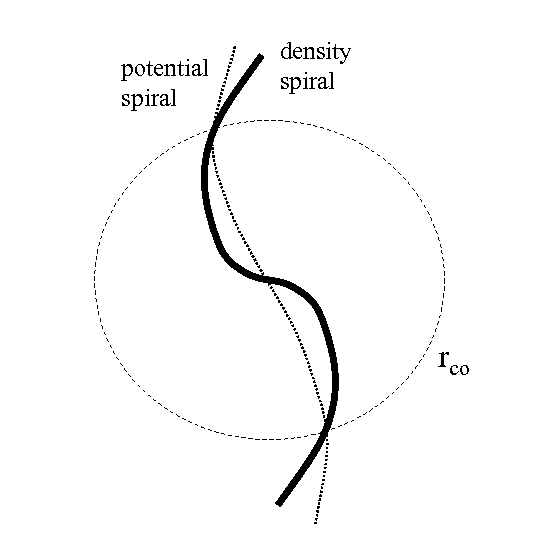|
The potential-density phase-shift is a useful tool for probing
the structure and evolution of galaxies. The idea was developed
by Dr. Xiaolei Zhang, currently affiliated with George Mason
University, in a series of Astrophysical Journal papers
published in the
1990s. Since 2005, Dr. Zhang and I have collaborated on
applying her ideas to real galaxies. The papers at right are
our most detailed applications so far.
Click here to see a figure that summarizes some of our main findings from the two studies.
 This schematic (courtesy
Dr. X. Zhang) shows
the basic idea of the Zhang theory as applied to a spiral
galaxy. The density spiral leads the potential spiral inside
the corotation resonance radius, rCo, and
trails the potential spiral outside rCo.
These phase differences cause a galaxywide torquing action that
changes sign at corotation and can influence the evolution
of the basic state of the galactic disk. This schematic (courtesy
Dr. X. Zhang) shows
the basic idea of the Zhang theory as applied to a spiral
galaxy. The density spiral leads the potential spiral inside
the corotation resonance radius, rCo, and
trails the potential spiral outside rCo.
These phase differences cause a galaxywide torquing action that
changes sign at corotation and can influence the evolution
of the basic state of the galactic disk.
|
"The Potential-Density Phase-Shift Method for Determining the Corotation Radii in Spiral and Barred Galaxies", by X. Zhang and R. Buta, Astronomical Journal, 133, 2584, 2007
"Corotation Radii from Potential-Density Phase-Shifts for 153 OSUBGS
Sample Galaxies," by R. Buta and X. Zhang, Astrophysical Journal Supplement Series, 182, 559, 2009
|


 This schematic (courtesy
Dr. X. Zhang) shows
the basic idea of the Zhang theory as applied to a spiral
galaxy. The density spiral leads the potential spiral inside
the corotation resonance radius, rCo, and
trails the potential spiral outside rCo.
These phase differences cause a galaxywide torquing action that
changes sign at corotation and can influence the evolution
of the basic state of the galactic disk.
This schematic (courtesy
Dr. X. Zhang) shows
the basic idea of the Zhang theory as applied to a spiral
galaxy. The density spiral leads the potential spiral inside
the corotation resonance radius, rCo, and
trails the potential spiral outside rCo.
These phase differences cause a galaxywide torquing action that
changes sign at corotation and can influence the evolution
of the basic state of the galactic disk.